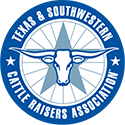Kleingrass (Panicum coloratum)
Kleingrass (Panicum coloratum) is a warm season perennial bunchgrass that is native to Africa and one of the most desirable forage grasses for cattle because it provides a very economical source of grazing. It also makes high-quality hay.
- Is a tufted grass with fine stems arising from a firm, knotty base
- Has leaves that are 1/16 to 3/16 inches wide with scattered hairs on the leaf margins
- The seedhead is an open panicle with many spikelets that have hard, shiny seeds
- The plant can reach a height of 20 to 50 inches, depending on field conditions
Kleingrass is adapted to a wide range of soils and can be found in areas of the southern U.S. that have rainfall from 18 to 30 inches a year. It should be noted that kleingrass is not cold tolerant and can freeze in colder climates.
Kleingrass should be utilized as forage for cattle only because it can have ill effects on sheep, goats and horses. If sheep, goats or horses have access to kleingrass, monitor the animals closely for photosensitivity issues and liver problems.
Kleingrass can cause a condition called “swellhead” in sheep that can be fatal if not removed from pastures. Goats and sheep will exhibit signs of severe sunburn that results in problems with the eyes, nose and skin on the face or muzzle, progressing to death.
Horses do not exhibit the classical symptoms of photosensitivity. They will only appear as not doing well. Weight loss and poor body condition are common.
These ill effects are caused by saponins in the grass that lead to liver damage, which can be lethal. Green growing grass appears to cause the most problems. Cured or dormant forage does not seem to have the same toxicity. To be safe, horses should not be allowed to graze or eat hay from kleingrass. Animals showing symptoms often make a full recovery when kleingrass is removed from their diet.
Kleingrass is utilized by many wildlife species, including whitetail, which eat the grass in very early spring because it greens up early and provides good-quality grazing. Many birds also use the seed as food and ground-nesting species take advantage of the grass clumps as nesting areas. The variety “Verde,” released in 1982, has a larger seed that many bird species prefer. ❚
Editor’s note: Kent Ferguson, retired rangeland management specialist from USDA Natural Resources Conservation Service (NRCS), is providing us with plant identification photo stories to help ranchers identify those forbs, forages and species growing in the pastures. Additional photos provided by USDA NRCS.
Kleingrass is excerpted from the June 2017 issue of The Cattleman magazine.


